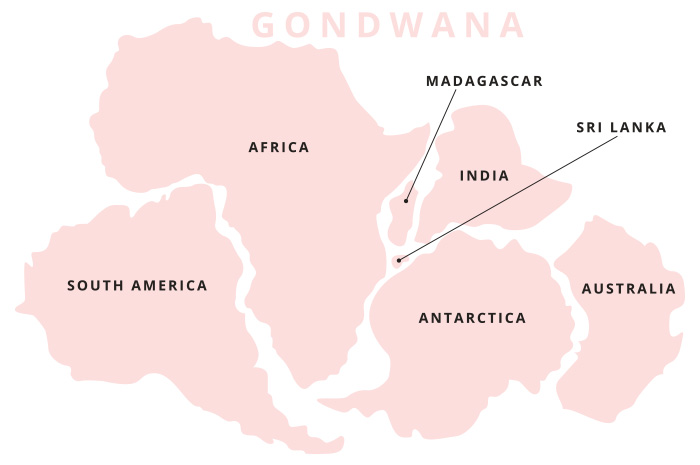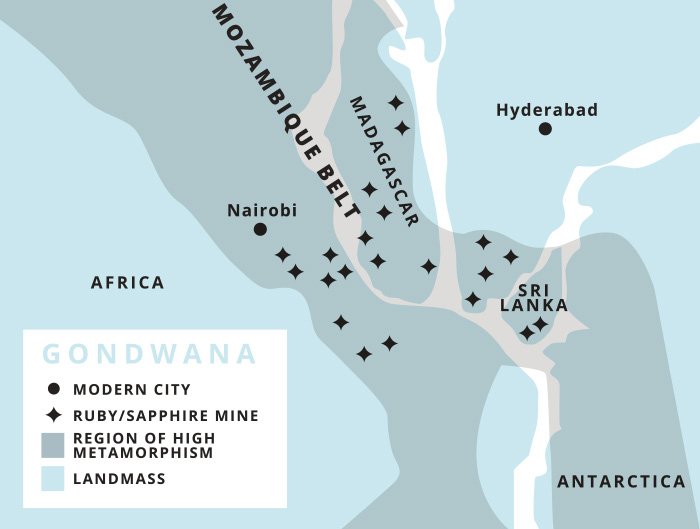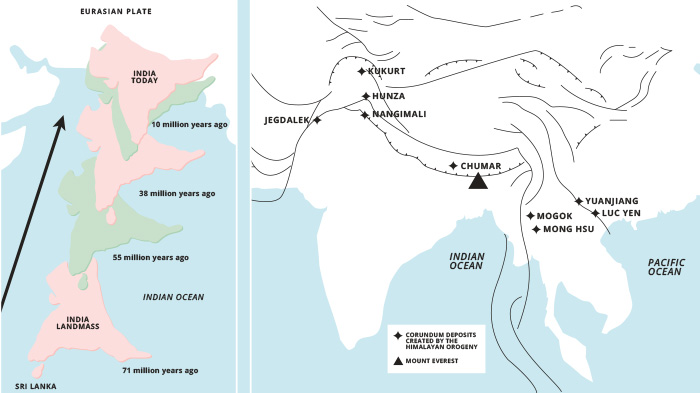Did you know that Rubies and Sapphires are made of the same thing - two parts aluminum to three parts oxygen (Al2O3)? Both gemstones are varieties of what is known as Corundum. Corundum deposits are some of the most widely dispersed of all the gemstones on the planet.
The most significant deposits can be found in Madagascar, Thailand, Sri Lanka, Myanmar (Burma), Australia, India, the USA, Nigeria, Tanzania and Mozambique. So how did this gem end up spread across such disparate areas? The answer lies in plate tectonics…
How Do Rubies and Sapphires Form? All About Corundum Tectonics
Almost all inorganic gemstones are formed in the Earth’s crust. The few famous rule breakers are Peridot and Diamond, which form deep in the mantle. But almost every other inorganic gem is formed in the crust, as a result of the heat and pressure associated with huge tectonic events when continents collide. These tectonic events bring together diverse rock types – and with them a diverse range of possible chemical reactions, to create a greater variety of mineral formations.
We have as many gemstones as we do due to a happy coincidence. Life forms began to grow beyond microscopic size around 635-542 million years ago. As these sea creatures died, their remains created a layer of oceanic sediment, eventually forming limestone. At around the same time, the Pan-African orogeny (the plate movements creating the super-continent known as ‘Gondwana’) brought together most of the continental crust on the surface of the planet at the time.

The limestone created in the oceanic crust was crushed between continental crusts. The former Mozambique Ocean closed up, causing the limestone layer to metamorphose into marble. This marble came into contact with clay soils during this orogeny – this was essentially an acid + base reaction, which combined with the heat and pressure of tectonic collisions, created the perfect conditions for gemstones (and particularly Corundum) to form. This gemstone-rich area is known as the ‘Mozambique Belt’.
The Pan-African orogeny produced Corundum deposits in Kenya, Tanzania, Mozambique, Madagascar, Sri Lanka and southern India. These are around 500 million years old.

Almost all other Ruby and Sapphire deposits were created in either the Pan-African orogeny described above, or in the Himalayan orogeny (circa 50 million years ago). These Corundum stones are around a tenth of the age of those from the Mozambique Belt.
This huge tectonic event, when the Indian plate separated from Gondwana and slammed into Central Asia at (by geological terms) phenomenal speed, created the mountain ranges of the Himalayas and Earth’s highest peak, Everest. Fossilized sea creatures have been found in the limestone at the summit of Everest, testament to the truly extraordinary forces involved!

The Himalayan orogeny produced pockets of Corundum deposits stretching across Afghanistan, Tajikistan, Pakistan, northern India, Nepal, Myanmar (Burma), China and Vietnam. In other areas, notably Thailand, Corundum was formed through volcanic action. This map shows the ways in which deposits have formed across the globe. Note the younger gemstones in the north of India and the older ones in the south.

Corundum Chemistry
The chemists among you may be wondering how Corundum, which is a crystalline form of aluminum oxide (Al2O3), forms from the interaction of marble and clay, let alone how Corundum of a variety of colors can form.
It is thought that some clay on the periphery of continental crusts metamorphosed into shale. During this process, hydrothermal solutions containing the necessary aluminum, as well as such trace elements as chromium or vanadium, were deposited in the shale. This shale became layered through the marble, and crystals of Corundum grew on the boundaries between these rock types.

To complicate things further, in some Corundum mines, you may have noticed that the gem Spinel is also mined. The Luc Yen and Mogok mines in the Himalayan Belt and the areas around Mahenge in the Mozambique Belt produce both Corundum and Spinel.
The reason for this is that there are actually two different varieties of 'marble'. The most straightforward is simply Calcite (CaCO3), which combined with the aluminum deposited in shale can create Corundum of varying colors. The ‘other’ marble is actually dolomite (CaMg(CO3)2). As you can see, this is a more complex rock, containing magnesium. When dolomite and shale come together under the high temperatures and pressures associated with these huge geological events, the aluminum in the shale and the magnesium in the dolomite join together to form Spinel (MgAl2O4). It is only when all of the magnesium is used up that Corundum can form in these locations.

This, perplexingly, means that in dolomite-marble gem-rich areas, Spinel is more abundant than Corundum. However, since there are more calcite-marble gem-rich areas in total, Spinel is rarer than Corundum overall.
This does not mean that Corundum isn’t rare, however. Fine quality Rubies and Sapphires are some of the more sought-after gemstones on the planet, fetching astonishing prices. They are also far, far rarer than Diamonds.
This fascinating story leads to wonderful gemstones that can be faceted and set into jewellery. To browse our fine selection of jewellery featuring Ruby, Sapphire and Fancy Sapphire (which is the name for any Sapphire that isn't blue) choose from the below links.
Click here to see Ruby jewellery designs.
Click here to see Sapphire jewellery designs.
Click here to see Fancy Sapphire jewellery designs.

